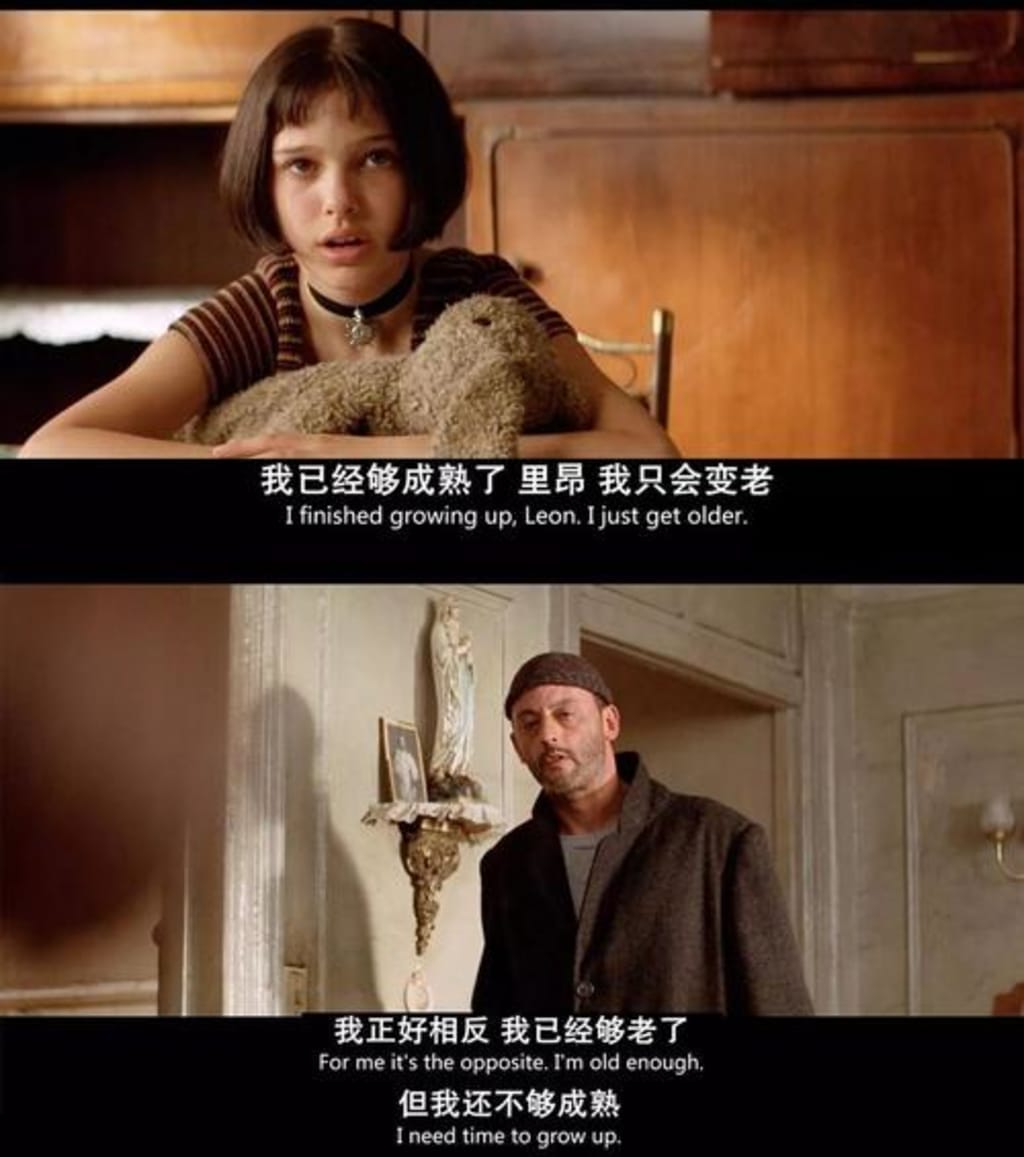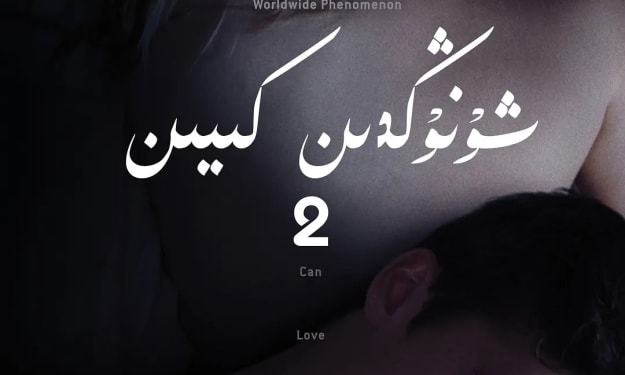
The mutual comfort of two lonely souls,
Embrace each other for warmth, and seek salvation for the soul
1. Introduction: This film tells the story of a 12-year-old girl who fled to her home in killer lyon after being killed, and pinned her love and hope on this middle-aged man. They live together every day, and Lyon promised to teach Mathilda how to be a killer the day after tomorrow. They get along with each other day and night, and gradually produce ambiguous feelings across ages. In the end, Lyon died in a confrontation with the police in order to avenge Mathilda.
Second, the theme:
1. Love. At the beginning of the film, the director set a series of scenes to show Leon's loneliness: he has no fixed place, wanders around, and runs away from the world ... The only thing to accompany him is an orchid that never gives up. 12-year-old weak, helpless and pitiful Mathilda, because she couldn't enjoy the warmth of her family since she was a child, and was killed by a mafia, longed for a support and protection. Although Mattilda was weak, she showed maturity and strength that were out of proportion to her age. Mathilda ironed clothes for Leon, made breakfast, played games and danced beautifully, which melted Leon's lonely heart. Leon's strength has become an object that Mathilda can trust and rely on. For a long time, sharing life and death, living together and keeping warm with each other make it inevitable for the two protagonists to have love. In fact, the main theme of this film is not Tilda's revenge, nor Leon's life and death, but their bizarre and touching love affair. With the development of the plot, their emotions gradually deepen and get better, and then vanish in the final moment of sublimation. The perfection of emotion lies in its imperfection. It is better to terminate an emotion that is difficult to continue at the climax. After all, only in this way can the emotion last forever.
2. The change from "rule" to "love" shows the beauty of human nature. Lyon, the hero, was an inhuman killer at the beginning, but later took in Matilda, a young girl, lived and played together, and began to enjoy every day. At the end of the film, Lyon needs to make a choice, whether to continue to be a lone killer or to help Matilda become an open-minded ordinary person. He chose the latter, and this change killed him, but he was happy when he made the choice, and realized that he had never felt happy, which was his growth. Lyon faces two choices: killer life is principle and rule, while Matilda represents love. When love tears away rules, principle loses to love, and it is the beauty of human nature that drives him to change.
3. Redemption and being redeemed. For Mathilda, Leon is a trustworthy and reliable object, but for Leon, isn't she the golden sunshine that suddenly appeared in the latter's black life? We are both unhappy -- to the sky's end, coupled with the long-term mutual affection, shared life and death, so these two souls who are equally lonely and eager for warmth naturally get closer and closer, and finally a subtle spark is struck. Although Leon finally sacrificed his life to save Mathilda, he will not regret falling in love with her. Because of her, he relived the joy of life, felt the sweetness of feelings, and saved his own soul. He finally used his own blood to clean up the sins he had committed. Mathilda will not regret giving her first love to this middle-aged man named Leon, because it is him, so that she can be protected from harm, relive the warmth of her long-lost family, understand the true meaning of feelings, and learn how to cherish them.
Third, the character analysis:
1. Professional killer lyon: At the beginning of the film, a close-up shot of the five senses of the characters was given, wearing sunglasses, and the words simply showed MoMo of Lyon as the killer. After that, in several scenes of his killing, he killed all his opponents without showing up. When he put the knife rest on the other side's neck, he gave a close-up shot, still wearing dark glasses, and it was dark behind him, and the color of the picture looked dark and dim. When he left, the outline gradually disappeared into the dark, giving the audience a kind of MoMo killer who lived in the dark for a long time. Later, when he entered a new residence, one of the things he did was to look around and see if it was safe. Let the audience feel that Lyon was a professional killer with rigorous work and extraordinary skills. In the film, Lyons slept in sunglasses for many times, and did not forget to put a gun beside him as a panoramic shot for self-defense. The color was still dark.
Although Leon is middle-aged, and he is silent, cold, witty and capable, under his unsmiling appearance, he hides a gentle, kind, innocent and simple heart. The lonely killer life for many years makes him feel lonely and lonely, and the only bright color in his life is the tequila. He cultivated it as his own life. Unconsciously, this pot of green plants became his only friend in his life. In his eyes, it was even another self.
2. Rebellious and simple Mathilda: A 12-year-old girl who experienced various contradictions in her family. A girl who lacks love, resents and resents all this, and becomes rebellious. Several close-up shots of TV are given in the film, showing that the little girl likes watching cartoons, and multiple shots of holding dolls can reflect her inner simplicity and weakness, but the reality does not allow her to lie about her age and suddenly change the camera. She needs to hide to be mature and strong.
Fourth, audio-visual language
1. the use of music
In this film, several beautiful melodies are used to set off the atmosphere of the film. The violin music at the beginning and the clarinet melody image when LEON is lonely are all very distinct. When LEON and Mathilda met for the first time, they first played guitar melody with LEON's actions, and when Mathilda appeared, they added piano melody. The combination of the two reflected a quiet and beautiful atmosphere. And this piece of music came to a screeching halt when the bad guys appeared, which made the sudden change of atmosphere just right. In addition, drums have been used many times in this film's music. In the first gun battle scenes, such as LEON killing and Stan killing, with the constant tension of the atmosphere, fast, deep and powerful drums were added in time, which increased the tension and penetrating power of the film. Music will make the finishing point for movies. It can be said that in LEON, the handling of these music adds a lot to the film.
2. Wonderful editing.
Commercial films pay attention to fascinating plots and fast and concise rhythm processing. LEON, as an excellent commercial film, has a good performance in editing. For example, in the first scene of the film, the director boldly used 20 partial close-up shots at the beginning. Although there were no complete characters, he clearly explained the events and the identities of the characters. The beginning of this still hiding half her face from us behind her guitar not only breaks the routine but also increases the mystery, which is refreshing. This kind of treatment makes professionals take it as a classic.
3. About LEON's image building.
The creator avoided the direct display of LEON's murder scene. In several murder scenes, death is mostly expressed by indirect means. For example, in the first gunfight scene, the atmosphere of the whole scene was tense, but only the blood splashed on the ground, the hanging legs and a large number of bullet holes exposed on the door were used to show the murder, which not only did not give the audience excessive bloody and horrible stimulation, but reflected LEON's extraordinary skill. In this way, the film gradually forms the audience's closeness to the hero LEON, and avoids the damage to the hero image caused by murder and violence. In the last gun battle, there were a lot of violent scenes. This time, it showed the cruelty of the world and LEON's bravery, thus reaching a "tragic" state.
4. Exquisite visual effect.
There have been many gun battles in this film, but the handling of each gun battle is different. The first gun battle-the picture is strong sunshine, warm color, the first half is bright, the second half is dark, forming a strong contrast effect, most of which are motion shots, and the hero LEON only appears in the last shot. The second shootout-it is also warm, with moving and fixed shots, and the tone is softer. The third gun battle-this paragraph has the light of shaking flashlight. This scene is cool, and it also uses a lot of moving shots, including a lot of long shots. In this film, LEON always has fewer enemies and more bullets, but in order to avoid the monotony caused by the repetition of the plot, "LEON" takes great pains in light, tone and the way of using the lens.
5. Montage
Opening the door for Mathilda in Lyon to save her. A cross montage showing a close-up of Mathilda's expression in Lyon is given in the film. Lyon was nervous and hesitant, and Mathilda was afraid and looking forward to it. The killer was never alone, but his inner goodness played a role and finally opened the door. Mathilda's camera outside the door, the color of the picture has been in a cool color, and the light is dim. When the door is opened, the camera shines on Mathilda's face, and the color turns into warm color. She smiled because she saw hope and light. Killer's life has always been monotonous. But because of Mathilda's intervention, Lyon's life changed from now on. When Amadi played games with Lyon, the light became cloudy and bright, which was no longer as dim as when Lyon was alone before. The color of the picture is also the warm color of French warmth, in order to show this wonderful moment.
The director also used lyrical montage. In Lyon's parting shot to save Mathilda, the close-up shot of the two sides in the film shows the pain of parting between life and death. The words "Mathilda, I love you" and "I love you too" deeply touched the audience. In fact, Mathilda's love for Lyon has a kind of sustenance, because she has never been so protected and cared for. Two lonely people walk together and depend on each other. When Lyon finally survived, he was ready to walk out of this horrible and dark building, and the camera gave him a close-up of his face. He stared at the outside, and the sunlight shone on his face just like Mathilda before, because he saw hope and sunshine. But at that time, another person appeared in the dark, Stanley. This abominable man is pointing a gun at Leon. Then Stanley's subjective shot and Stanley's close-range shot are used in cross montage. Finally, the close-up of the gun was recorded, and then it was converted to Lyon's subjective lens. The background music was always lyrical light music, just like Lyon's mood. The camera suddenly flashed white light, and Lyon was shot. The picture was still bright but gradually became hazy, and it landed quickly. The lens was pulled out from Lyon's subjective lens and turned to the panoramic lens of two people. The man still kept looking at the outside. Music, along with Lyon's mood and gentleness, always has a vision for the future, until the hope is dashed. The typical application of sound and picture counterpoint makes us realize Lyon's satisfaction from the beautiful piano music. I'll see the beauty of this not-too-cold killer.
6. Milk and "Green" Hope
Milk: There are two items in the film from beginning to end, namely milk and dragon tongue orchid. Lyon's drink is not wine or drink but milk, and there is a close-up of the milk cup he just finished. The film pays attention to the shooting of milk, which not only shows that Lyon doesn't drink alcohol, but can keep awake and calm. It can also show that Lyon's heart is as delicate and gentle as milk, not as strong-willed as wine.
Tequila (green plant): There is also Lyon's favorite tequila, which they will take with them wherever they go. Don't forget to water it, don't forget to bask in it, and the film always gives agave panoramic and close-up shots. No matter before Lyon or later Mathilda took care of agave, when it was placed on the balcony, it was always shot in the right light, and the bright colors seemed particularly bad. Later, Lyon did not forget to save tequila when fighting the police. This shows the importance of tequila to him. Finally, Mathilda transplanted tequila from the pot to the backyard of the welfare home. With STING's "shape of my heat", the lens gradually zoomed out. That tequila not only symbolizes Lyon's love of life and yearning for a better life. In the end, it directly symbolizes Lyon itself, resting here, no longer worrying, and living the quiet life he yearns for.
Behind the film, we vaguely try to tell us that even though killer lyon is in the dark, the pure goodness of the human heart is the cornerstone that supports our spiritual world. The whole film is not only of great value in the lens art, but also the human concern and enlightenment from the film reminds each and every one of us to be kind to ourselves and life. It must be said that this is a classic work that will undoubtedly go down in history forever.





Comments
There are no comments for this story
Be the first to respond and start the conversation.